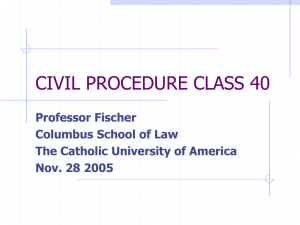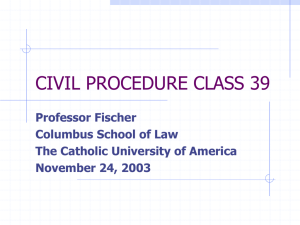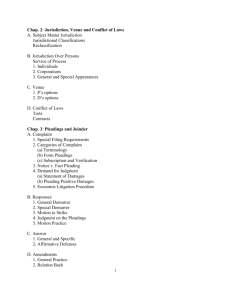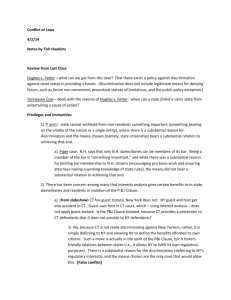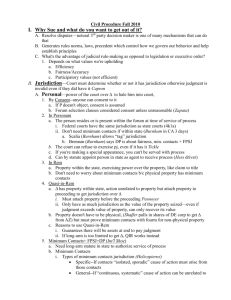Civil Procedure Cheat Sheet
advertisement
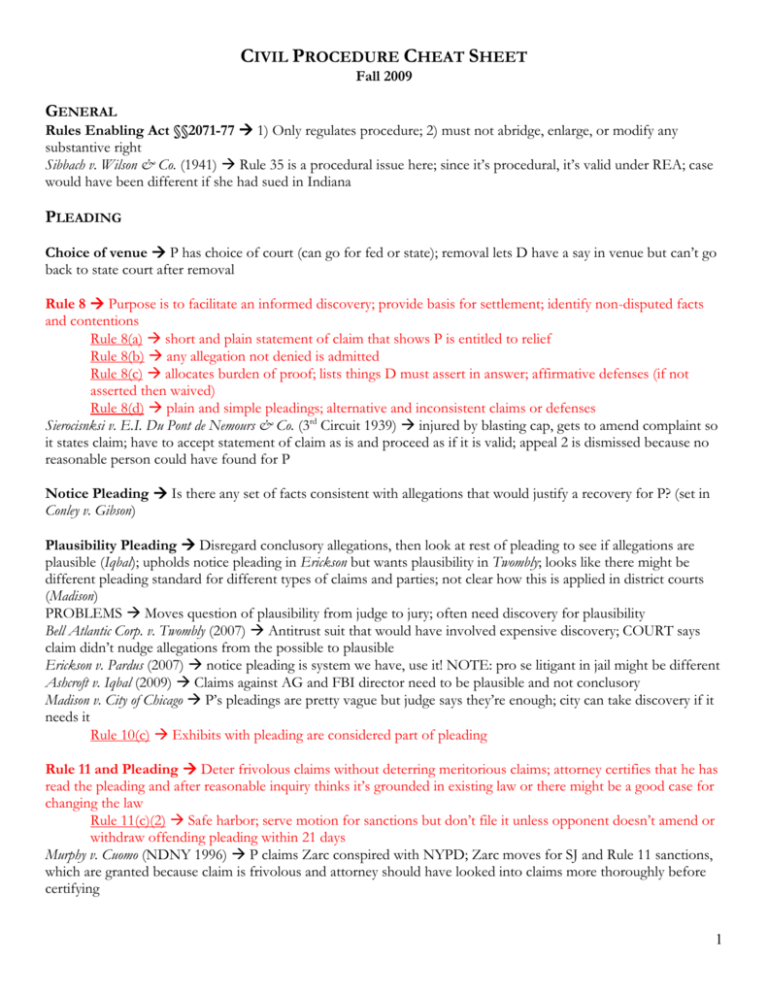
CIVIL PROCEDURE CHEAT SHEET Fall 2009 GENERAL Rules Enabling Act §§2071-77 1) Only regulates procedure; 2) must not abridge, enlarge, or modify any substantive right Sibbach v. Wilson & Co. (1941) Rule 35 is a procedural issue here; since it’s procedural, it’s valid under REA; case would have been different if she had sued in Indiana PLEADING Choice of venue P has choice of court (can go for fed or state); removal lets D have a say in venue but can’t go back to state court after removal Rule 8 Purpose is to facilitate an informed discovery; provide basis for settlement; identify non-disputed facts and contentions Rule 8(a) short and plain statement of claim that shows P is entitled to relief Rule 8(b) any allegation not denied is admitted Rule 8(c) allocates burden of proof; lists things D must assert in answer; affirmative defenses (if not asserted then waived) Rule 8(d) plain and simple pleadings; alternative and inconsistent claims or defenses Sierocisnksi v. E.I. Du Pont de Nemours & Co. (3rd Circuit 1939) injured by blasting cap, gets to amend complaint so it states claim; have to accept statement of claim as is and proceed as if it is valid; appeal 2 is dismissed because no reasonable person could have found for P Notice Pleading Is there any set of facts consistent with allegations that would justify a recovery for P? (set in Conley v. Gibson) Plausibility Pleading Disregard conclusory allegations, then look at rest of pleading to see if allegations are plausible (Iqbal); upholds notice pleading in Erickson but wants plausibility in Twombly; looks like there might be different pleading standard for different types of claims and parties; not clear how this is applied in district courts (Madison) PROBLEMS Moves question of plausibility from judge to jury; often need discovery for plausibility Bell Atlantic Corp. v. Twombly (2007) Antitrust suit that would have involved expensive discovery; COURT says claim didn’t nudge allegations from the possible to plausible Erickson v. Pardus (2007) notice pleading is system we have, use it! NOTE: pro se litigant in jail might be different Ashcroft v. Iqbal (2009) Claims against AG and FBI director need to be plausible and not conclusory Madison v. City of Chicago P’s pleadings are pretty vague but judge says they’re enough; city can take discovery if it needs it Rule 10(c) Exhibits with pleading are considered part of pleading Rule 11 and Pleading Deter frivolous claims without deterring meritorious claims; attorney certifies that he has read the pleading and after reasonable inquiry thinks it’s grounded in existing law or there might be a good case for changing the law Rule 11(c)(2) Safe harbor; serve motion for sanctions but don’t file it unless opponent doesn’t amend or withdraw offending pleading within 21 days Murphy v. Cuomo (NDNY 1996) P claims Zarc conspired with NYPD; Zarc moves for SJ and Rule 11 sanctions, which are granted because claim is frivolous and attorney should have looked into claims more thoroughly before certifying 1 DEFENSES; REPLYING Interposing defenses and objections D must take action against complaint or default judgment will be entered in P’s favor; only a good plan if you are positive there’s no TJ; can use 55 or 60(b) to have it set aside, but need a good reason Time calculation 12(a) 21 days to make a motion or file answer (MOTION NOT A PLEADING); motion denied, clock for filing answer is reset to 10 days (12(a)(4)) Rule 6(a) if due date is on weekend or holiday, time extends to following Monday Rule 6(b) extending deadlines for good cause or excusable neglect Rule 12 Tells D how to make objections and motions. Typically D moves against complaint on various 12 grounds; if motion denied, then submit answer 12(b) how to present defenses pretty much always make 12(b)(6) motion; TJ, SMJ, PJ, venue, failure to join; use affidavits to support 12(e) and (f) Court may ask for more definite statement, have 10 days; motion to strike redundant claims; must be filed before responsive pleading because you can’t answer without more definite information 12(h) waive lack of personal jurisdiction, improper venue, insufficient process, insufficient service of process if don’t raise in first answer (motion or answer or in both); can raise 12(b)(6) at any point until trial; lack of SMJ can be raised at any time AND by court (sua sponte); have chance to amend once through 15(a)(1) Rule 7 Enumerates the various pleadings allowed; P may not reply to affirmative defenses unless court orders reply 7(a)(7) Coleman v. Frierson (NDIL 1985) D tries to get judgment set aside but all of their defenses (claim preclusion, 12(b)(6)) should have come in original pleadings so court says no Statute of Limitations Want to prevent evidence from going stale and give D peace of mind; starts running as soon as last event has occurred; usually a bright-line rule that bars claim 2 COUNTERCLAIMS; AMENDMENTS; JOINDER OF CLAIMS Rule 13: Counterclaims if counterclaim comes out of same transaction or occurrence, it is timely even if SOL has run (a) COMPULSORY: have to make counterclaim if it arises from same transaction or occurrence (is the evidence the same?) (b) PERMISSIVE: D can raise if he wants but doesn’t have to; not barred from bringing it later but a good idea to bring them all at once (g) CROSSCLAIMS: Co-parties assert claims against on another that bear relation to controversy at hand; involves judicial discretion; can’t bring in parties that aren’t already joined Transaction and occurrence same evidence to support or refute opposing claims? “Whatever may be done by one person which affects another’s rights and out of which a cause of action may arise.” Williams v. Robinson (D.C. 1940) Husband says Mr. X should have counterclaimed in divorce proceeding Rule 18(a): Joinder of claims Ps may join as many factually unrelated claims (independent or alternative) as they have against D Rule 15: Amendments Lets you fix things you forgot to put in the pleading; get to amend by right once before the responsive pleading is served motion is NOT a pleading for these purposes; also new rules say that you get 21 days to amend as soon as a 12(b), (e), or (f) motion is served (a) Amendments before trial; get to amend once by right; after that have to seek leave of court who gives it when justice so requires; if P amends complaint D gets to amend answer within longer of 14 days or remaining time (b) Amendments during and after trial; reframe case if different than you thought it was; trial by consent lets you try things if both sides new issue existed but forgot to put it in pleadings (c) Relation back of amendments; (1)(A) if state law allows you to relate back when SOL has run, then it’s ok to amend the claim; (1)(B) covers asserting a new claim out against same D out of same T or O; and (C) lets you change party or naming of party Beeck v. Aquaslide (8th Circuit 1977) D initially admits making slide then sees it and moves to amend answer to deny making it; D says D had no bad faith and have to consider prejudice against them if denied motion to amend Blair v. Durham (6th Circuit 1943) amendment did not state a new claim so SOL tolled 3 DISCOVERY Purpose lets parties find out all relevant facts, contentions, and proof. Facilitates settlement and creates more effective SJ; encourages broad joinder How discovery unfolds Parties confer under 26(f) & make proposed discovery plan; Submit written discovery plan, exchange initial disclosures; 16(b) scheduling order Rule 26(f) conferences that set terms of timing and sequence of discovery as required under 26(d) 26(a)(1) initial disclosures that everyone is going to want no matter what; 26(b)(1) can only take relevant discovery Rule 16(b) scheduling order covers joinder, amendments, motions, and discovery; makes judge mange everything Rules 30-32: Depositions 10 presumptive depositions per side, limited to one 7-hour day; written questions given ahead of time; live depositions have attorneys sitting in; HAVE TO NOTE OBJECTIONS AT TIME Umprehes v. Shell Oil Co. (what is conspiracy?); Brandenberg v. El Al (BA asks to elaborate on claims; has to answer because facts) Rule 33: Interrogatories limited number of written questions answered by responding party and lawyer together; can ask for facts and contentions O’Brien v. International Brotherhood seek an application of law to fats, and this is fine because attorney is present at all times; not unfair Rule 35: Physical and Mental Examinations condition must be in controversy in the action and movant must show good cause; Schlagenhauf v. Holder (applies to Ps and Ds, but have to make sure not a fishing expedition) Rule 36: Requests for admission ask other party to admit truth separately set for or to admit genuineness; denial better be for a good reason or there will be sanctions; more binding than interrogatories Freed v. Lackawanna Railway D says train outside limits in interrogatory, says inside limits in trial. D was supposed to tell P, but interrogatory isn’t binding so it’s ok Evidentiary Privilege Work-product: must have been created when litigation had already begun or was reasonably expected, can get it if there is substantial need for materials; only waived when giving it to 3rd party means opponent might get it; Attorney-client: protects communications in both directions between attorney and client; can waive it if disclose to any TP Electronic Discovery rules amended so court takes control and costs don’t spiral out of control PRE-TRIAL Rule 16: Pre-trial Conferences (a): let’s court take control of way trial is run; (b) scheduling: sets time limits for pleadings, motions, discovery, etc.; (c): can have one or more relatively early to address concerns; (e): final conference just before trial to make trial plan including admission of evidence, also last chance for settlement Identiseal v. Positive ID Systems Judge compels discovery, this is not OK Pre-trial disclosures (37(c)(1)) If don’t give opponent witness lists, etc. then unlikely you can use evidence at trial Schuber v. S.S. Kresge Co. No indication that P’s husband will be witness, so P can’t amend to include what husband says; bound by pre-trial procedures; RULE 11 sanctions Rule 68: Settlement If P turns down D’s offer and actual settlement is less, P has to pay D’s costs; can’t use settlement offer against other side to prove liability; Class actions have some exceptions Kothe v. Smith don’t settle malpractice suit, judge imposes sanctions for not settling, Ct. App says only parties get to settle cases, not judges 4 TERMINATING LITIGATION WITHOUT TRIAL Rule 12(c): Motion for judgment on the pleadings like a delayed 12(b)(6) that can be made by either party at end of pleading stage; solely on matters of law with disputed facts considered to benefit non-movant Rule 56: Summary Judgment No evidence to support a claim, no support for trial = SJ; can only concern pleadings and discovery and allege no material facts in dispute; supported by affidavits; use caution because based on paper evidence; take as true then look in light favorable to non-movant; SCOTUS wants courts to use SJ (trilogy) Summary Judgment vs. 12(b)(6) motion 12(b)(6) = no claim; SJ = question of fact? AA v. Ulen Judge grants SJ because there’s no question of fact; usually this case would have gone to jury because it was about negligence and that’s a classic mixture of law and fact Scott v. Harris Reasonable force when ramming car; 8 justices say yes, no dispute of material fact JURIES Rules 38 and 39 Can waive right to jury trial if don’t bring it up within specified time; generally no right when based in equity; 7th Amendment doesn’t cover state governments, so might not have right to jury trials there Rules 47 and 49 Selection of jurors TRIAL Evidence Only admit relevant evidence (but this is often ruling on substantive law); exclude out of court statements offered to prove truth of matter asserted (hearsay); object as soon as you realize something is wrong (want it taken out or noted so can appeal later); impeach evidence to combat it Rule 51: Jury instructions given by judge by both parties allowed to submit instructions they want judge to use; have to object as soon as judge give you opportunity or as soon as you find out what instructions will be Rule 49: Verdict (General and Special) special is written finding on each issue of fact Rule 50: Judgment as a matter of law at trial and immediate post-judgment equivalent of SJ; based on live testimony; have to file under 50(a) before jury so non-moving party can fix problems first; try once before then again within 10 days after trial (RJMOL); can get JMOL for each issue SJ vs. JMOL TIMING; also paper as opposed to real evidence Rule 59: Granting a new trial; altering/amending judgments might give it if you think jury should decide one way but don’t want to use JMOL; verdict must be against great weight of evidence; can also move to have judgment set aside 5 JUDGMENT; APPEAL Entry of final judgment starts clock for appeal, give preclusive effect, puts into place disposition of law suit Rule 58: Entering judgment (a): separate documents; (c): outer time limit for when appeals time starts running Rule 54: Judgment; Costs (b): direct final judgment to your claim if there are multiple parties so you can get out sooner; (d): nominal cost shifting, but can seek them if you want; should do it sooner rather than later Rule 50(b): RJMOL renew JMOL as long as made it before judgment to upset the judgment now Rule 59: Motion for a new trial can also use 59(e) to try and alter or vacate judgment Rule 60: Relief from a Judgment or Order use when outside time for JMOL or new trial; (b) changes substance of judgment; harder to get relief because notion of finality is pretty strong; judgment is void because no TJ, SMJ or DP Remedies Damages; 57: DJ: gives you determination of legal rights and obligations before doing anything that renders you liable; injunctive relief Appeals §1291: can only appeal when final judgment; also interlocutory appeals (need DC judge’s certification and Ct. App’s approval) Dilly v. S.S. Kresge D appeals SJ and denial of motion to amend but court says no because not final judgment nor interlocutory appeal; doesn’t have jurisdiction to hear it Ways around final judgment rule Interlocutory appeal; class action appeals (23(f)); Extraordinary writs (mandamus); Collateral order JOINDER Rule 19: Required Joinder (a): necessary parties (bring in if can); (b): indispensible parties (take a harder look to see if really can proceed without them; balancing test); want to craft relief to limit prejudice to unjoined party Rule 20: Permissive Joinder can join actions of multiple Ps as long as same T & O; also join multiple Ds with same T & O but pay attention to service of process, TJ, and diversity Rule 14: Third Party Practice (Impleader) Allows D to sue third party and become TPP; original P can assert claims against TPD if from T & O; look into TJ and diversity; file within 10 days of answer or seek leave to amend Rule 22: Interpleader don’t want double liability; works for Ps and Ds Rule 24: Intervention (a): as of right, court MUST let you join if you have substantial interest in outcome; (b): can join if have a claim or defense that shares common question of law or fact; no destroying SMJ Rule 23: Class Action (a): numerosity, commonality, typicality, adequacy; (b): have to meet at least one of the tests; must get court’s permission to settle; members of class must get notice and have opportunity to opt out 6 ERIE DOCTRINE Five Step Analysis 1) Arguably procedural?; 2) Conflict?; 3) On point (Walker, Hanna)?; 4) Outcome determinative (twin aims of Erie, Hanna; inequitable administration, Walker)?; 5) Federal interest in applying fed law (Byrd, Gasperini)? Erie Fed courts must apply state statutes OR common law for states in cases of diversity jurisdiction; state law governs outcome of claims that are decided on state law; no federal common law State Law highest court, certification, predictions, Bernhardt v. Polygraphic Co. (old VT law on books, follow it) Choice of Law fed courts sitting in diversity and those hearing supplemental state law claims use choice of laws rules that would be applied by court of the state in which it sits (Klaxon) Outcome determinative test York says to apply state law if there is a fed procedure different from state law that would affect litigation result; BUT Hanna says that you have to look to the twin goals of Erie York use state or fed SOL apply state if have different results Ragan Conflict with KS law for when action commences and fed Rule 3 not on point, use KS longer life Hanna v. Plumer Service by state or federal rules twin aims of Erie Twin Goals of Erie forum shopping: don’t want law to make a difference to where P decides to bring suit; inequitable administration: will the result be unfair? (Walker) Walker Allowing Rule 3 to govern would result in longer life for claim not fair West v. Conrail No SOL in fed labor relations so use NRLA Rule 3 is on point State vs. Federal Interests Byrd says if there’s an overriding federal interest in applying fed law then use it!; Gasperini: balance interests of state and fed Szantay v. Beech not really any state interests (uses Byrd) federal practice Day & Zimmerman Have to apply TX COL rules under Klaxon can’t just make things up (use Cambodia laws) Gasperini state standard in trial court, fed standard for appellate review of abuse of discretion hybrid of both interests Prior Swift v. Tyson (federal common law, creates forum shopping) 7 8 SUBJECT MATTER JURISDICTION Article III Creates SCOTUS and authorizes them to hear certain types of claims; rest is up to Congress § 1331: Federal Question Jurisdiction P’s well-pleaded claim must raise a question of fed law OR state law claim that turns on an important question of fed law AND fed jurisdiction wouldn’t upset balance of power; Satisfied 1) Explicitly; 2) Implicitly (Bell v. Hood); 3) state law with important fed question (Smith, Grable) Mottley Want lifetime of free RR passes because of accident; federal questions must come in P’s original claim Bell v. Hood 4th and 5th amendment violations by FBI; P doesn’t have to show that claim is valid, just that it arises under fed law BUT can’t be wholly insubstantial and frivolous Smith v. Kansas City does element turn on an important question of fed law?; Grable v. Darue State law turns on federal question AND it wouldn’t destroy balance of powers AND wouldn’t swamp courts § 1367: Supplemental Jurisdiction 1) Own reason for being in fed court under §1331/1332?; 2) Supplemental claim arise from common nucleus of fact (Gibbs test)? 3) Fall under one of §1367(b) exceptions (14, 19, 20, 24)? (only for Ds AND diversity; if diversity is met, then fine) Owen Equipment v. Kroger Carter Lake; Supplemental jurisdiction destroys diversity; also P chose where to sue, don’t want way to circumvent diversity; D could bring impleader claim without destroying diversity because didn’t choose to be there UMW v. Gibbs Common nucleus of operative fact § 1332: Diversity Jurisdiction Amount in controversy > $75,000, can legal possibility that can exceed even if don’t claim full amount, can add multiple claims from one P against one D, can’t add two Ps’ claims against one D unless common and undivided interests; complete diversity necessary St. Paul Mercury v. Red Cab failure to recover jurisdictional amt is not grounds for dismissal just have to claim the amount Aggregation of claims Can aggregate for purposes of meeting amt in controversy in supplemental jurisdiction as long as you are a P and one of the Ps meets the amount in his own; parties must be diverse, though (Allapattah) Citizenship can’t improperly or collusively join parties to get diversity (§ 1359, Kramer v. Caribbean Mills); fraudulent joinder doctrine (no factual basis for claims; P has no intent to pursue claims but joined Ds to prevent removal), Rose v. Giamatti Domicile mind and behind; intent to remain indefinitely, physically present in state OR place where have been most recently physically present; place where born Baker v. Keck (moves to OK with intention of staying) Removal Ds can remove based on SMJ or diversity; unrelated counterclaim shouldn’t be removed; rule of unanimity says all Ds have to agree to removal § 1441: Actions Removable Generally (a): could P have brought it there originally? (b) Diversity only ok if none of Ds seeking removal is citizen of state in which action is brought; (c) remove whole case, including claims that wouldn’t be in district court’s jurisdiction Shamrock P tries to remove, but can’t because § 1441(a) says removal by defendants NOT Ps 9 TERRITORIAL JURISDICTION Two Prong Test (that leads to more tests) 1) Authorized by government that created court? (look to 4(k)(1)(a)); 2) Constitutional? Minimum contacts (Shoe), Reasonableness (Asahi) Minimum contacts number of contacts and degree of relatedness; one contact is enough if it directly relates to suit International Shoe minimum contacts test number of contacts and degree of relatedness between suit and contacts with the state McGee Reaching out into state by mailing contract meets minimum contacts; purposeful availment Hanson v. Denckla unilateral move by other party is not enough to meet minimum contacts Burnham v. Superior Court being served while in state confers jurisdiction because 1) in-hand service is good enough OR 2) there are minimum contacts because he’s been driving around CA for 3 days Gray v. American Radiator stream of commerce argument knew it would get there WWV First minimum contacts, then reasonableness; Stream of commerce D didn’t offer product with the expectation that they would be purchased by consumers in forum state; foreseeability is not enough Asahi Even if minimum contacts met still have to look at REASONABLENESS not met BK link between minimum contacts and reasonableness strong showing of contacts means it’s more reasonable for him to be sued there DeJames Can aggregate national contacts according to 5th amendment but still need statutory authority for service of process Kulko v. Superior Court Need voluntary contacts Omni Capital v. Rudolf Wolff FCEA doesn’t provide authorization required under 4(k)(1)(a) Rule 4: Summons if it’s ok for a state court to hear case, then it’s ok for fed court to hear it; 4(k)(2) aggregate claims with US for minimum contacts, still have to do constitutionality In rem jurisdiction still need minimum contacts (Shaffer) Pennoyer territorial jurisdiction dependent upon presence in state Harris v. Balk Debt travels with H Schaffer v. Heitner do the Shoe minimum contacts analysis for quasi in rem type 2 Mullane jurisdiction by necessity, also goes through analysis of various parties’ interests Rush v. Savchuck just because IC is in state doesn’t mean R has minimum contacts; nothing to do with him Full Faith and Credit Clause Article IV, Section 1 states have to enforce each other’s valid judgments Full Faith and Credit Statute § 1738 Federal courts have to enforce state court judgments Bases for general jurisdiction Presence: Darrah (in VA); Grace (in plane); NO Wyman (fraudulently induced to FL); Domicile: Milliken; Consent: Hess v. Pawloski (MA driving), Adam v. Saenger (P can’t object to jurisdiction because brought suit there); Continuous and systematic contacts: Helicopteros, Perkins (“doing business”) 10 11 VENUE § 1391: Venue generally Diversity (where any D lives, substantial portion of events occurred); SMJ (where any D lives, substantial portion of events occurred); where any D is subject to PJ or where they may be found if no other district escape hatch; can sue aliens; do a reasonableness test Forum non conveniens court won’t hear case because of serious inappropriateness of forum; today just for foreign Ds Gulf Oil Do a reasonableness test § 1404: Change of Venue when venue was proper to begin with; to any venue where the action might have been brought (look to 1391 and 1441); use original venue’s laws; convenience of parties and in the interest of justice; for Ps and Ds Van Dusen Have to apply state law from original venue Norwood §1404(a) transfer less stringent than dismissal, use more discretion Hoffman v. Blaski actions of D after suit was brought have no bearing on which forums are appropriate Ferens v. John Deere Have to apply old laws no matter who transfers; bad system, not bad statute § 1406: Cure or Waiver of Defects transfer when venue was wrong; apply laws of new state; venue where it could have been brought originally; for both Ps and Ds; works even when transferor court can’t obtain PJ even if venue is proper Goldlarr transfer allowed no matter how wrong P’s choice was and whether or not court had PJ Martin v. Stokes transferee law applies § 1631: Venue transfer to cure want of jurisdiction transfer to venue in which claim might have been brought to cure want of jurisdiction DUE PROCESS Procedural due process 5th amendment for fed, 14th for states notice and opportunity to e heard BEFORE government impairs property or liberty interests; in-hand service always good; notice must be reasonably calculated to actually notify them; try to notify like you really want to notify them Service of Process follow state law requirements in state; Rule 4 for fed; notice must be reasonably calculated to notify parties and give them chance to voice objections; take steps if you know it’s failed Mullane notice must be reasonably calculated to notify parties as you would if you actually wanted to notify them Mennonite v. Adams even if certified mail failed, take more reasonable steps like personal service Jones v. Flowers tax office knew it wasn’t delivered, should have tried harder Rule 4(k): Territorial Limits of Effective Service tells you when and how you can serve people (within 100 miles of issuing court, within a judicial district) SEIZURE Notice before seizure interim remedies (D might take it away, destroy it, etc.); safeguards (bonds, sanctions, affidavits, specific allegations, judge); give D hearing Balancing Test Matthews v. Eldridge 1) What is nature of deprivation; 2) How big a risk is there that government will screw it up? 3) What is government’s interest in doing it this way instead of having more safeguards? Sniadach v. Family Finance Corp. Wages are special; provide notice and opportunity to be heard before garnishment Fuents v. Shevin procedure failed 14th amendment because didn’t give notice and opportunity to be heard BEFORE seizure Mitchell v. W.T. Grant D can seek immediate dissolution of seizure, which is fine because includes constitutional accommodation of conflicting interests of parties North Georgia Finishing No provision for an early hearing after seizure and need procedures to guard against errors; bank account NOT an appliance; clerk NOT a judge 12 CLAIM PRECLUSION Second cause of action is the same if it refers to all the same grounds for relief as first suit Counterclaim also subject to claim preclusion not if brought in court where D couldn’t get full relief and D couldn’t transfer Elements 1) Valid and final judgment (no TJ and lack of DP means D can collaterally attack); 2) On the merits; 3) Same or related claim; 4) Same parties/privies Remember! Preclusion can still attach while appealing; if judgment vacated, preclusive effect gone Williamson v. Columbia Gas Claims are for same thing with different theory, PRECLUSION (JOINDER, PEOPLE!) Smith v. Kirkpatrick Actions concern different theories with different elements of proof and evidence not preclusive O’Brien v. City of Syracuse same action barred Sutcliffe Storage v. US Preclusion because same cause of action each time and could have brought them all together Commercial Box Lumber v. Uniroyal two different claims out of different actions = NO preclusion COULD have joined under 18(a) bud didn’t HAVE to Harrington v. Vandalia-Butler Second suit should have been pleaded in first claim; doesn’t matter that law changed in middle because could have claimed it first time Adjudication not on the merits judgment on some question of law or fact not something insubstantial 41(b) (outline) Waterhouse v. Levine only determination was that it was prematurely brought not on merits, not preclusive Keidatz v. Albany judgment entered by demurrer is not enough to grant claim preclusion Rinehart v. Locke Same claims but with one missing allegation barred because of claim preclusion, P should have APPEALED Counterclaim Where you supposed to assert a compulsory counterclaim? If you didn’t, tough luck Horne v. Woolever Barred because H was supposed to bring car crash injuries claim under 13(a) Menard v. Liteway P should have brought payment counterclaim in first suit preclusion; simply collateral attack in disguise Dindo v. Whitney NOT claim preclusion because D had a bad lawyer and didn’t know he could assert the claim Schwabe v. Chantilly didn’t have to counterclaim when they asserted fraud; also don’t want to upset judgment #1 Estoppel Equitable: acted inconsistently at an earlier time with what they’re trying to do in this lawsuit and there was detrimental reliance on part of estopping party; Judicial: Took a prior inconsistent position in a prior judicial proceeding (tension with alternative and inconsistent theories in Rule 8. Court might make you pick one) 13 ISSUE PRECLUSION Elements 1) Valid and final judgment; 2) Issue (fact/fact & law); actually litigated and actually determined; 3) Necessary to judgment; 4) Same parties/privies EXCEPT non-mutual Exceptions to Issue Preclusion 1) lots of alternative judgments each of which is sufficient to fulfill the judgment; 2) burden switches from one suit to the other; 3) limited jurisdiction; 4) public interest; 5) different procedures; 6) party couldn’t have appealed; 7) special posture; 8) strong policy against limiting exceptions Little v. Blue Goose Issue preclusion because judgment in suit 1 required finding BG was no negligent for them to recover Cambria v. Jeffrey No issue preclusion because #1 was determined on J’s contributory negligence NOT C’s negligence Home Owners relaxes Cambria but MA goes back to it Halpern v. Schwartz judgment resting on three alternative grounds is not preclusive as to any of the grounds (not common) Malloy v. Trombley Can apply issue preclusion even if it is an alternative as long as it was fully litigated AND the trial court decision was very careful Jacobson v. Miller execution wasn’t a fact actually litigated and determined in first suit, so J isn’t barred from contesting execution in #2 Exceptions to rule If facts on ground or governing law have changed in such a way that we’re no longer talking about the same issue, then we should conclude that issue preclusion does not apply Moser Civil War dude, same facts preclusion Montana Income tax, issues same preclusion Courts of limited jurisdiction issue preclusion might apply if previous court didn’t have authority, but who knows? Inconsistent judgments Last judgment in time is controlling (Donald v. J.J. Lumber, Berlitz v. Everest House) Unforeseeability of future litigation Court will not apply issue preclusion if application was unforeseeable at time of initial action and unforeseeability may have affected how hard party litigated matter (Evergreens v. Nunan, Spilker, Federated Department Stores) Special Posture If P is in special posture in litigation without full and fair opportunity to litigated case no issue preclusion think trustee Privity Shorthand for saying that someone has a relationship with someone who was a party in suit 1 so that preclusion works; (Taylor v. Sturgell) can have privity if there are overlapping interests and a relationship if interests are aligned and party looked out for absent party’s interests Show-World Center v. Walsh No privity between landlord and Show-World because no legal relationship and different interest Neenan v. Woodside Astoria Transportation Not a party nor in privity no issue preclusion NON-MUTUAL ISSUE PRECLUSION Defensive Coke v. Pepsi P deliberately selects forum and unsuccessfully presents proofs if bound by adverse judgment in second suit with identical decided issues Bernhard v. Bank of America serving exact same interests and exact same set of people issue preclusion Blonder-Tongue Laboratories Don’t want to have D present full defense on merits to something P already litigated and lost 14 Taylor v. Hawkinson No issue preclusion because original verdicts were compromise verdicts Offensive 1) Could person who wants to use it have joined in first suit? 2) Are there procedural opportunities available in suit 2 that weren’t available in suit 1 that could lead to a different outcome? 3) Are there other reasons why it would be unfair to D? (Parklane Hosiery) Preclusion and the Government Can’t use offensive non-mutual issue preclusion in suits where US is a party; don’t want to appeal everything (no resources); more cases against US than anyone else; SCOTUS would have to change cert process (US v. Mendoza) ISSUES CHECKLIST 1. Personal Jurisdiction Issue? 2. Subject Matter Jurisdiction Issue? a. Removal? Remand? 3. Venue Issue? Transfer? 4. Erie Doctrine Issue? 5. Pleadings Issue? 6. Motion Issue? 7. Discovery Issue? 8. Class Action? 15
